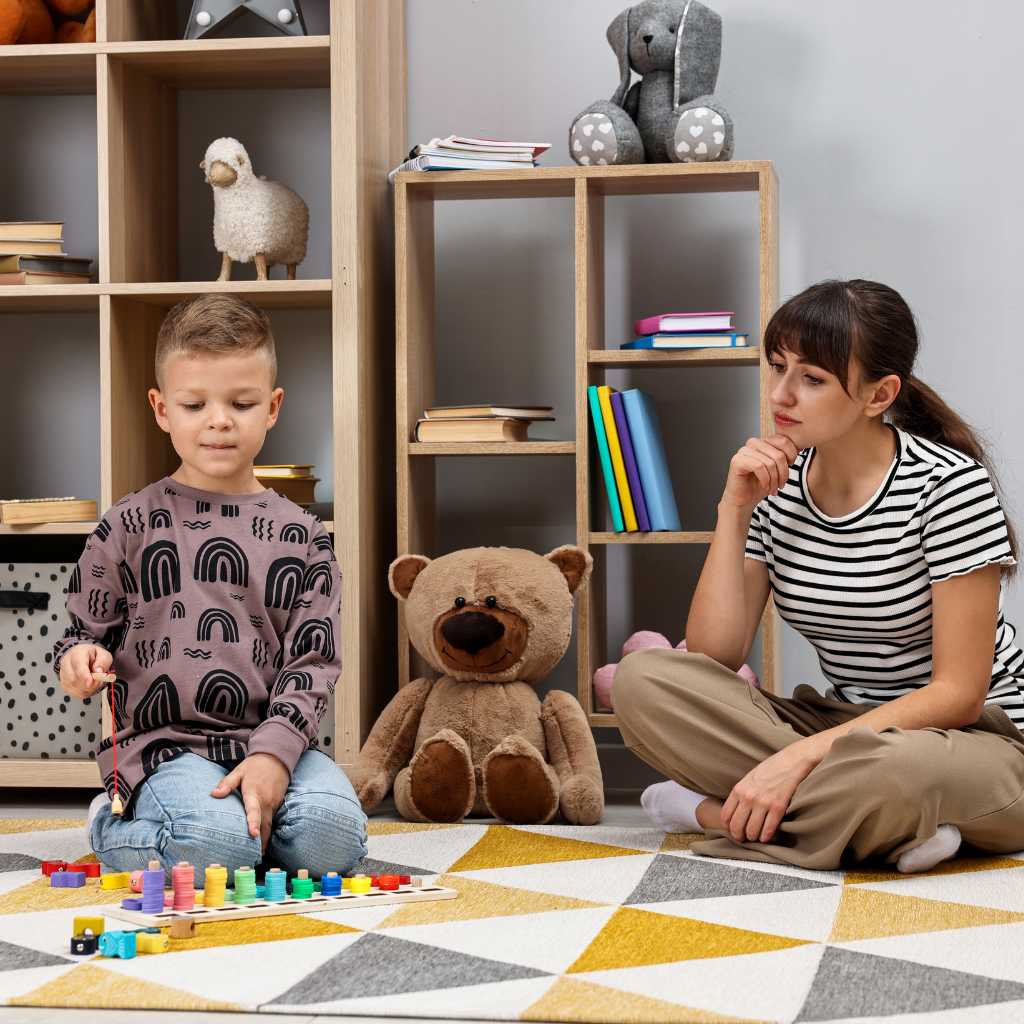Tabla de contenidos
Autism spectrum disorder (ASD) affects individuals differently, which is why the DSM-5 classifies it into three levels of support needs: Level 1 autism, Level 2, and Level 3. These levels help professionals describe how much assistance someone might require in daily life, from minimal to very substantial support.
Among these, Level 1 autism is considered the mildest form, and some people call it “high-functioning autism.” Children and adults at this level typically have strong verbal and cognitive abilities but may still face meaningful challenges with social communication, flexibility, and sensory regulation.
Does my child have autism level 1?
This is a question that many parents ask themselves when they start noticing differences in how their child communicates, interacts, or adjusts to new routines. The answer can be complex and emotional, but also empowering. Understanding what Level 1 autism means can help families access the proper support and build an environment where their child can thrive.
En este blog de ABA Centers of Florida, we’ll explore what Level 1 autism looks like, how it affects daily life, and what therapies and resources, like Applied Behavior Analysis (ABA), can make a real difference.
What Is Level 1 Autism?
The term Level 1 autism comes from the Manual Diagnóstico y Estadístico de los Trastornos Mentales (DSM-5), which defines ASD according to three levels of support needs. Autism Level 1 is considered the mildest form of autism.
Children and adults with Level 1 autism typically demonstrate cognitive abilities in the average or above-average range and strong language skills. Still, they often struggle with subtle aspects of communication and social understanding.
According to research published in SunText Reviews, individuals at this level may have difficulty initiating or maintaining social interactions, interpreting nonverbal cues, and adjusting to changes in routine.
They might appear “independent” in many ways but still require structured support in social and emotional areas, especially in school or workplace settings.

Common Signs of Level 1 Autism in Children
Every child on the autism spectrum experiences the autism traits uniquely. However, there are several key characteristics commonly seen in children with Level 1 autism:
Subtle Social Challenges
Children may want to make friends but struggle with understanding how to do so naturally. They might dominate conversations about their favorite topics or miss cues that others are losing interest. For example, a child could talk endlessly about dinosaurs without noticing that peers want to change the subject.
Rigid Routines
Even minor disruptions to a routine can trigger distress. Studies have found that children with autism level 1 often use routines as a coping mechanism to manage anxiety and predictability.
Sensory Sensitivities
Light, noise, or textures can feel overwhelming. A buzzing fluorescent light or scratchy clothing tag might cause discomfort or distraction that others wouldn’t even notice.
Focused Interests
Many children with Level 1 autism develop intense interests in specific topics, like maps, trains, video games, or astronomy. These passions can be both a strength and a challenge: they inspire deep learning but can also make social interactions harder if the child has trouble shifting topics.
Subtle Communication Differences
Unlike children at other autism levels, those with Level 1 autism usually speak in complete sentences. However, their tone, rhythm, or facial expressions may come across as unusual. They might interpret language very literally, missing sarcasm or figurative expressions.
Autism Levels: Understanding the Spectrum
To understand autism level 1, it helps to see where it fits within the broader autism spectrum. The DSM-5 categorizes ASD into three levels of support needs:
- Level 1: Requiere apoyo
- Level 2: Requiere apoyo sustancial
- Level 3: Requiere apoyo muy sustancial
While autism levels are helpful for clinical understanding, many professionals caution against labeling individuals solely based on these categories. A recent study from Frontiers in Psychiatry highlights that support needs can vary depending on context. What looks like Level 1 autism in a quiet home might resemble Level 2 in a noisy classroom.
Diagnosis of Level 1 Autism

Diagnosing Level 1 autism can be challenging because symptoms can be subtle and adults can easily mistake them for personality traits, social anxiety, or ADHD. Early detection relies on multidisciplinary assessments that consider communication patterns, social behaviors, and developmental history.
Professionals such as developmental pediatricians, psychologists, and Board Certified Behavior Analysts (BCBAs) play a vital role in evaluating whether a child meets the criteria for autism level 1.
En ABA Centers of Florida, our diagnostic process involves:
- Comprehensive developmental assessments
- Parent and caregiver interviews
- Behavioral observations across different environments
- Standardized testing to identify social, cognitive, and communication strengths and challenges
The earlier the diagnosis, the earlier intervention can begin, and research consistently shows that early support significantly improves outcomes for children with autism.
Daily Life with Level 1 Autism
Living with Level 1 autism often means navigating invisible struggles. A child might perform well academically but feel exhausted from managing social expectations all day. They may mask their discomfort to fit in, something studies in PMC call “camouflaging”, which can lead to stress, anxiety, and burnout over time.
Parents often notice that their child “holds it together” at school but experiences meltdowns at home due to sensory or emotional overload. Understanding this pattern is crucial to offering empathy rather than punishment or frustration.
Teachers and caregivers can help by:
- Providing clear instructions and predictable routines
- Offering quiet spaces for sensory breaks
- Using visual supports like picture schedules
- Encouraging interest-based learning to build engagement
How ABA Therapy Supports Children with Level 1 Autism
terapia ABA efectiva is one of the most effective and evidence-based treatments for individuals across all autism levels, including Level 1 autism. At ABA Centers of Florida, we design personalized treatment plans that help children develop practical skills while respecting their individuality and interests.
Here’s how ABA therapy makes a difference for autism level 1:
Enhancing Social Communication
ABA therapists teach children how to read body language, share conversations, and understand social rules, skills that may not come naturally to them.
Building Emotional Regulation
Therapists use strategies like behavior modeling and positive reinforcement to help children recognize emotions and respond appropriately, reducing frustration and anxiety.
Promoting Flexibility and Coping Skills
ABA programs help children adapt to change and manage transitions, so routines feel less overwhelming.
Strengthening Independence
From self-care to organization, ABA therapy supports daily living skills that empower children to succeed at home and in school.
Supporting Parents and Caregivers
ABA therapy isn’t just for the child; it includes parent training to ensure that caregivers can reinforce positive behaviors and create consistent routines at home.
These approaches are always individualized. A child fascinated by math might learn communication skills through number-based games, while another who loves art might build social awareness through collaborative drawing activities.
Supporting Your Child Beyond Therapy
Raising a child with Level 1 autism is an opportunity to nurture potential. Parents can foster growth and confidence by:
- Encouraging their child’s interests and talents
- Teaching self-advocacy skills, like asking for help when overwhelmed
- Practicing mindfulness or relaxation techniques for emotional regulation
- Building connections with local autism communities and parent support networks
Autism Diagnosis and ABA Services at ABA Centers of Florida
En ABA Centers of Florida, we offer comprehensive diagnostic evaluations for autism, early intervention programs, and customized ABA therapy for children and teens. Our team of BCBAs, RBTs, and clinicians works closely with families to create compassionate, effective plans that encourage growth, communication, and confidence.
Whether your child is newly diagnosed with autism level 1 or you’re seeking additional support, our clinicians design programs to meet each individual where they are.
If you suspect your child may be at any of the autism levels, don’t wait to seek help. Early diagnosis and consistent support can lead to remarkable progress.
Póngase en contacto con ABA Centers of Florida today or call us at (772) 773-1975 to schedule an autism diagnostic evaluation or to learn more about how ABA therapy can support your child’s development.









